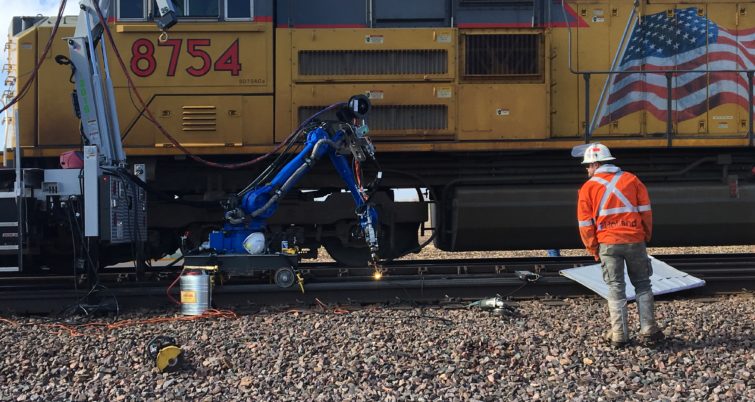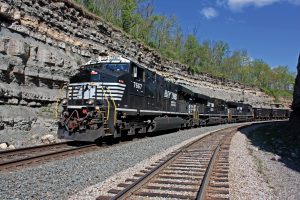In Alignment – Perfect Rail Symmetry Demands High-Quality Welding
Written by Jennifer McLawhorn, Managing Editor
RT&S AUGUST 2023 ISSUE – ATLANTA – While track maintenance has more than its fair share of challenges, it could perhaps be argued that rail welding is among the most challenging.
While track maintenance has more than its fair share of challenges, it could perhaps be argued that rail welding is among the most challenging. Welders must work to maintain the accuracy of the track geometry throughout. As rail ends are welded together, be it by electric flash-butt welding or thermite welding, it is imperative that rail ends are perfectly aligned. In order to do so, Class 1 and Short Line railroads alike both need high-quality materials to perform such tasks. What follows is a line-up of rail welding products and services currently offered that allow these railroad track maintenance departments to rise to the challenge.
Holland has continued to provide high-quality welds to its customers across North America and Australia for over fifty years. Offering its Intelliweld® Control System, it gives its operators and weld quality lab the ability to see real-time weld monitoring, control, and diagnostics for each weld performed. By doing so, the system enables a Weld Quality Conformance of 99.9%.

The newest addition to Holland’s welding portfolio is Short Plug Repair Welding. The flash-butt welding process allows for better quality and cost-effective defect remediation in comparison to traditional methods whilst necessitating less equipment and labor. In its’ short plug repair welding gang, 5’ plugs are used with two pieces of equipment and four (railroad and Holland) employees. Repairs can take up to an hour or more, and a single four-person crew can equal the efficiency of three thermite crews.
Holland told RT&S of its Automated Manganese Refurbishment, or HAMR™, and how it “provides robotically controlled welding procedures to build back the damaged areas on rail frogs and crossing diamonds, along with flash-butt welding services.” Holland reiterates its benefits which include a higher quality with lower porosity than other, more traditional methods as well as two to three times faster than the manual process. Regarding safety, operators are not required to work within range of the fumes for long periods of time since the robot can continue welding while trains go by on nearby tracks.
Holland provides a full refurbishment service with its HAMR™ weld warranty. Samantha Kozak from Holland told RT&S that within the last five years, Holland has “repaired over 350 frogs on multiple Class 1 and Short Line Railroads.” And just last year, “15 frogs that surpassed two to three years of traffic were noted during inspections which exceeded expectations!”
A leader in North American Thermit® welding, Orgo-Thermit manufactures both of its molds and Thermit® in a New Jersey facility. Michael Madden, President of North American Operations, tells RT&S that because of this, it makes Orgo-thermit “fully compliant with all Buy America requirements.”
Orgo-Thermit’s welding line includes their Safe Start Crucible, a patented product that eliminates the need for ignitors. According to Orgo-Thermit, this not only makes the welding process safer, but it also reduces costs of Hazmat transportation.
Its Thermit® 2.0 portion is the only one that has been developed to work with head hardened rail with a hardness of 370B. Moreover, it has an AREMA static slow bend test result of 0.8”, exceeding the test requirement of 0.6”. Madden also told RT&S that “with testing completed at TTCI on FAST,” Orgo-Thermit “demonstrated more than double the life of an Intermediate Hardness weld with 355MGT vs 171MGT.”
Along with PortaCo tools, Orgo-Thermit is able to offer a full range of tools to perform a Thermit® weld, and this also enables the company to provide support to its customers in every part of its application. Orgo-Thermit is able to meet all of its clients’ Thermit® welding needs with technical sales and service representatives across North America and a combined 120+ years of Thermit® welding experience.
With a focus on safety, Pandrol maintains its development of new products to address its customers’ needs. Among its recent developments of ATW products and services are its Battery Powered Pre-Heating System and Weld Shear, an Adjustable Mold, and a state-of-the-art lab in Memphis.

Pandrol’s High Flow Preheating System “provides a uniform preheat between the head and bottom of the rail which reduces stress in the weld,” according to Allen Goff, Senior Director of sales for Pandrol. The High Flow Preheating System, or HFPS, is complete in that it can replace some pre-existing preheating equipment.
While preheating processes now use a mix of oxygen and propane, Pandrol’s HFPS uses pure propane. This cuts the cost of oxygen needed and improves the experience of the welder because of its lower weight and smaller canister. Ignition, timing, and stop associated with the preheating process of the HFP are fully automated, and therefore, it eliminates the need for manual interference or flame adjustment.

Additionally, Pandrol offers a Light-Weight Battery-Operated Weld Shear. It works to achieve zero emission shearing and deliver quality shearing results that are both consistent and timely.
Among Pandrol’s rail welding offerings is an Adjustable Mold. A singular mold, it is able to be used for field weld applications that range from 132# worn to 141# rail profiles with a mismatch allowance of up to 1/8”. The advantage of a rail welding product like this one is that the customer only needs to stock one kit at the warehouse, and a welding crew only needs to carry one size on their truck. With a state-of-the-art welding lab in Memphis, Pandrol is also able to provide timely and detailed evaluations that complement its ATW product line.
With the number of eyes focused on the rail industry’s safety practices and infrastructure maintenance, the need for quality rail welding products and services is at a high point. As technology advances and companies develop more innovative products to its’ rail welding line-ups such as those listed here, the industry could hope to see fewer track failures.





